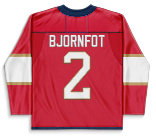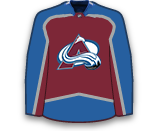Steen did not see any NHL playoff action despite the call-up and will head back to Providence (AHL) on Monday after being reassigned. Steen played in 64 games with Providence during the season, picking up 14 goals, 31 points and 34 PIMs.

Steen did not see any NHL playoff action despite the call-up and will head back to Providence (AHL) on Monday after being reassigned. Steen played in 64 games with Providence during the season, picking up 14 goals, 31 points and 34 PIMs.



Holm was 18-11-4 with a .911 SV% and 2.67 GAA with the Manitoba Moose (AHL) during the regular season and has been recalled on an emergency basis with expectations to back for Game 4 Monday. Holm has yet to see any NHL action in his career and will be replacing David Rittich (lower-body) for the duration of his injury.

Wallstedt was 18-15-5 this season with a .908 SV% and 2.68 GAA with the Iowa Wild (AHL) and has been recalled as Minnesota's third goalie for their playoff run. The 20-year-old was Minnesota's 2021 first-round pick (20th overall) and has yet to experience any NHL action.

Walker did not appear in any playoff games for Minnesota through two games and will head back to Iowa (AHL) for their playoff push. The 23-year-old had 27 goals, 21 assists, 23 PIMs and a +19 plus/minus through 56 games played with Iowa (AHL) during the regular season.

Driedger was 9-4-0 with a 2.61 GAA and .908 SV% with the Coachella Valley Firebirds (AHL) and has been recalled to Seattle to be their third goalie for the playoffs. The 28-year-old did not see any NHL action with the Kraken this season but has 65 career NHL games experience between Seattle, Florida and Ottawa.

MacEachern had 11 goals, 19 assists, 12 PIMs and a +8 plus/minus through 37 games with the Chicago Wolves (AHL) and has been recalled to Carolina on Thursday. The call-up comes on the news that Teavu Teravainen has a broken hand and will be out for the remainder of the playoffs.


Tufte had 19 goals, 16 assists, 90 PIMs and a +23 plus/minus through 63 games with Texas (AHL) during the regular season and has been recalled by Dallas on Wednesday as they deal with some injuries. The 25-year-old played in three NHL games in 2022-23, failing to pick up a point and going a -1 plus/minus. He will likely be an extra forward while we wait for more news on Joe Pavelski (undisclosed).

Kinkaid was 1-0-0 with a 1.37 GAA and .950 SV% in two appearances between Colorado and Boston this season but spent the majority of his 2022-23 in the AHL and has been recalled Tuesday to act as Colorado's third goaltender throughout the playoffs. The 33-year-old played in two NHL playoff games in 2017-18 with New Jersey, struggling mightily with his 0-2-0 record, 5.88 GAA and .804 SV%.

With Matt Murray still recovering from a concussion, Erik Kallgren has been recalled from the Toronto Marlies (AHL) as the Maple Leafs' third goaltender on the playoff roster. The 26-year-old appeared in 10 games for the Maple Leafs this season, posting a 3-2-4 record, with a .898 GAA and 2.67 GAA during his brief stint with the club early in the season.

Kochetkov had a 12-7-5 record, 2.44 GAA and .909 SV% with the Hurricanes' during the regular season and has been recalled from Charlotte (AHL) Monday to be Carolina's third goaltender. The 23-year-old saw four games worth of action with the Hurricanes' in last year's playoffs, with a 1-2-0 record, 3.89 GAA and .869 SV%.

Jones finished his 2022-23 regular season with an 11-17-9 record, 3.07 GAA and .905 SV% with the Iowa Heatlanders (ECHL) before seeing one game of action with the Iowa Wild (AHL) and has now been called up to Minnesota for the first time this season. The 22-year-old has likely been brought up as a third emergency option as there is no news of goaltender injuries at the moment in Minnesota's camp.

Bussi was 22-5-4 with a 2.40 GAA and a .924 SV% with the Providence Bruins (AHL) and has been recalled to Boston in time for the Playoffs. Bussi is a 24-year-old undrafted prospect for Boston and has yet to see any NHL action in his career.

Daccord was 2-1-1 with a .900 SV% and 3.14 GAA with the Seattle Kraken but has been reassigned to Coachella Valley (AHL) now that Martin Jones is expected to return from injury. The 26-year-old netminder returns to Coachella Valley, where he was an impressive 26-7-3 with a .918 SV% and 2.36 GAA.

Groulx played in two games for the Ducks, failing to pick up a point while collecting two SOG and has been reassigned to San Diego (AHL) on Friday. The 23-year-old returns to the AHL, where he had 18 goals, 21 assists, 41 PIMs and a -20 plus/minus through 61 games prior to his call up.

Helleson had a goal, four SOG, and two PIMs through three games with Anaheim but has been reassigned to San Diego (AHL) for the remainder of their season. The 22-year-old returns to San Deigo (AHL), where he had five goals, 13 assists, 50 PIMs and a -18 plus/minus through 63 games earlier this season.

Juulsen failed to pick up a point in 12 games with Vancouver but had six PIMs and a +1 plus/minus and has been reassigned to Abbotsford (AHL) after clearing waivers Friday. The 26-year-old returns to the AHL just in time for the playoffs, as he had three goals, 20 points, 34 PIMs and a +9 plus/minus through 49 games prior to his call-up.

Kelemen had a goal, 12 SOG, 23 PIMs and a -5 plus/minus through 14 games with Arizona this season but will head back to Tucson (AHL) Friday. The 23-year-old returns to the AHL, where he had 14 goals, 29 points, 37 PIMs and a -12 plus/minus through 58 games earlier in the season.
